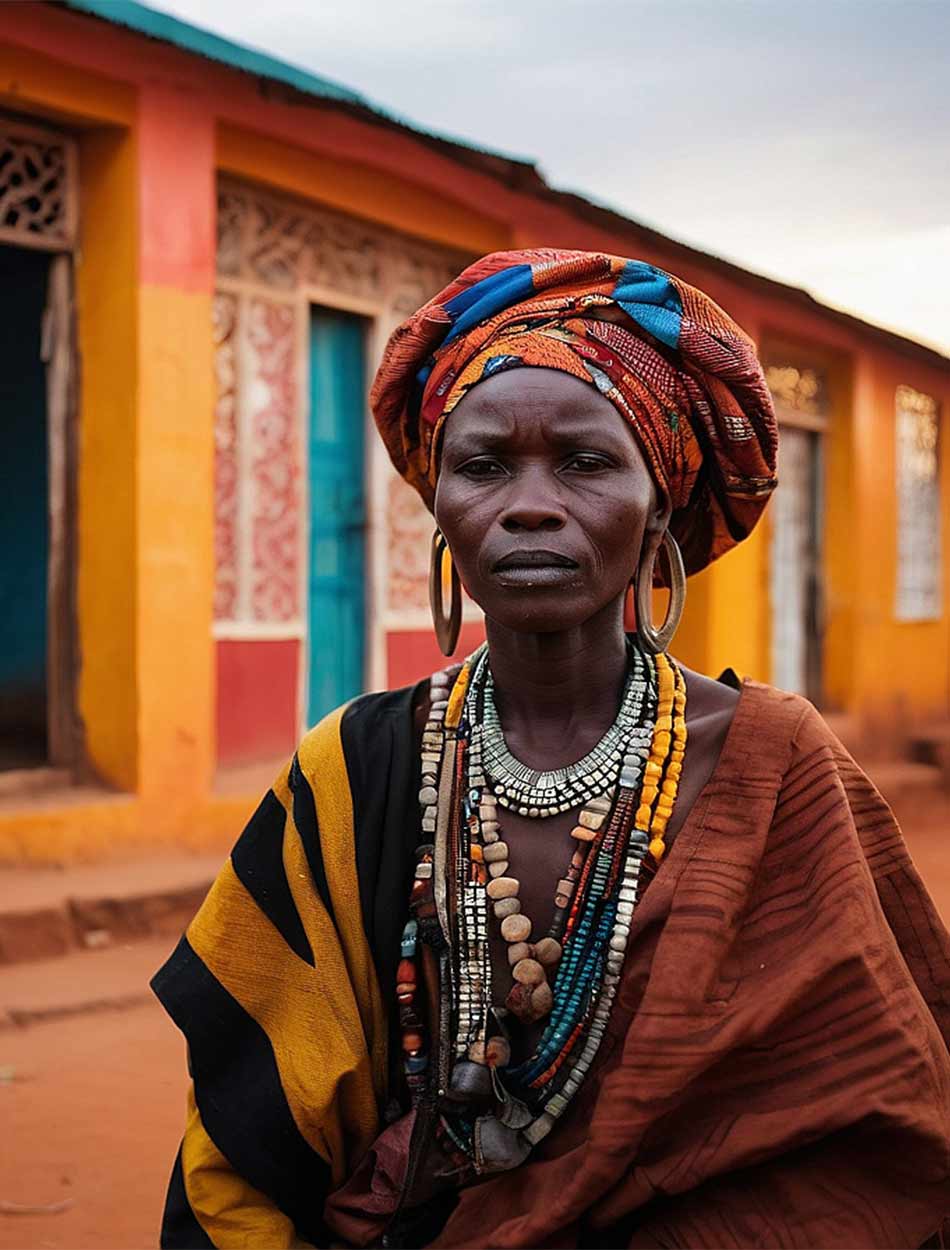
Dimensions in Ndebele Culture
Τhe Transvaal Ndebele constitute a captivating community with a rich history.
Let’s journey together into the vibrant world of their tribe, which brings forth a profound cultural heritage.
Behind the bright lines and intense colors of their walls lies a story of resilience, cultivation, and continuity.
We will explore the significance of colors in their daily lives, the symbols they craft with their hands, and their unique relationship with art.
Additionally, we will take a glimpse into the captivating story of Esther Mahlangu. Αn exceptional artist who has ingeniously intertwined the Ndebele tradition with contemporary art.
Initially facing challenges after their defeat in wars against the Boers, the Ndebele developed a unique tradition of house painting in the 18th century.
In the early 18th century, they lived in grass huts. The emergence of symbols on their houses began in the mid-18th century, with the transition to mud-walled buildings.
These symbols are not merely decorative elements but serve as means of communication among their subgroups, representing resilience and continuity in the face of challenges.
The colors and forms in the murals carry deeper meanings, representing personal prayers, ideals, emotions, and marriage.
The black edging and vibrant colors in today’s murals symbolize the evolution of their art.
With women keeping their spiritual heritage alive, wall art is not merely decorative but a key to the communal and cultural continuity of the Ndebele.
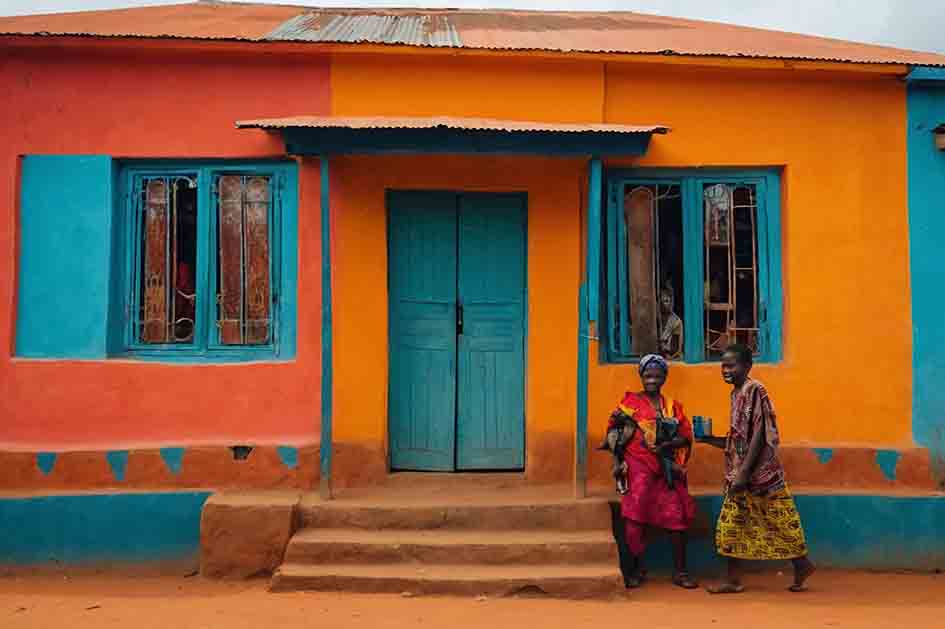
Historical Background of the Ndebele
The origin of the Transvaal Ndebele community traces back to the 17th century under the leadership of Musi, guiding his people to the Transvaal region.
The union with the Nguni people strengthens the community, fostering a rich culture.
The geographical division of the Transvaal Ndebele community stems from the need to confront Zulu invasions, leading to a separation into distinct tribes.
They relied on livestock farming and the cultivation of crops such as maize, millet, beans, sweet potatoes, and other produce.
The Ndebele, known for their warrior spirit and wealth in landownership, faced a period of intense adversity in the 19th century, experiencing defeat in conflicts with the Boers in 1883.
During these challenging times, symbols were created to convey their struggles, marking the origin of African art.
you can see a very interesting video about their lifestyle here
THE DEEPER MEANING OF THE DESIGNS
The paintings go beyond mere decoration.
They depict personal prayers, emotions, ideals, and even perspectives on marriage.
Initiation, known as “wela,” has been perceived as a reason for repainting homes, although this ceremony remains mysterious.
CONTINUATION OF TRADITION
Ndebele women emerge as custodians of tradition and primary creators of wall art.
Symbolizing the continuity of their culture, women take on the role of mothers. Passing down the cultural wealth and art of painting from generation to generation.
Through this ongoing succession, they keep their spiritual heritage alive and strengthen the connection of the younger generation with their history and tradition.
Thus, wall art is not merely a decorative form of expression but a key to the communal and cultural continuity of the Ndebele people.
Watch a very interesting video about the designs in their homes here
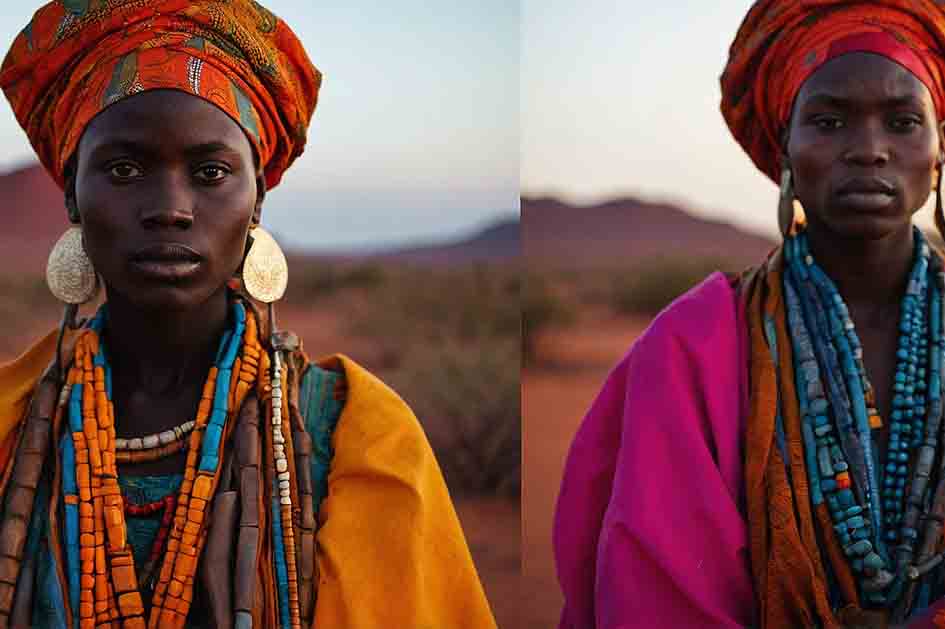
Symbolism of Colors among the Ndebele
For the Ndebele people, colors transcend mere decoration; they carry profound symbolic meanings, conveying messages about order, power, prayer, marriage, and protest.
Red and Dark Red: Symbolize vitality, strength, and energy. Often appearing in their geometric compositions, these colors create a striking sense of movement and vibrancy.
Yellow to Gold: Indicates wealth and good fortune. Frequently used to signify prosperity and success, whether expressed through an individual’s social standing or economic well-being.
Blue of the Sky: Typically associated with peace and carefree beauty. It represents the sky and the ethereal dimension, imparting an air of freedom and optimism.
Green: Expresses nature, earth, and fertility. It serves as a symbol of life and renewal, strengthening the Ndebele’s connection with their environment.
Occasional Pink: May represent love, femininity, or even mark a celebration like marriage.
Each color in Ndebele creations is intricate and rich in symbolism. Showcasing the diversity and deep connection of the Ndebele people to their culture and world. You can read an article of mine on the symbolic meaning of colors here.
NDEBELE AND FASHION
Ndebele women take great pride in their attire.
Their traditional clothing is colorful and bright, adorned with beautiful beadwork.
A woman’s traditional attire reflects her age and position in the community.
A married woman typically wears a blanket over her shoulders with thick, beaded hoops called “isigolwani” around her neck and legs.
Copper and brass rings or “dzilla” adorn her arms, neck, and legs.
The blanket or “nguba” usually features stripes of green, red, blue, yellow, and brown.
Married women also wear some form of head covering as a sign of respect for their husbands.
This can range from a beaded headband to a knitted cap or elaborate beaded headdresses known as “amacubi.“
Little girls wear beaded aprons or skirts, while those undergoing initiation wear numerous “isigolwani” around their necks, arms, legs, and waist.
They also wear “isiphephetu,” a beaded apron symbolizing their transition into womanhood.
Traditional attire for Ndebele men is less colorful than that of women.
The main clothing item for men is a breastplate or “iporiyana” hanging from the neck.
This is often adorned with beads and made from animal skin, symbolizing manhood and given to a young boy by his father after initiation.
Ndebele men also wear animal skin headbands and ankle bands.
To stay warm, they use an animal skin “karos” around their shoulders.
Animal skin plays a significant role in men’s attire, as each Ndebele group is associated with a different animal.
For rituals and ceremonies, men wear ornaments crafted by their wives.
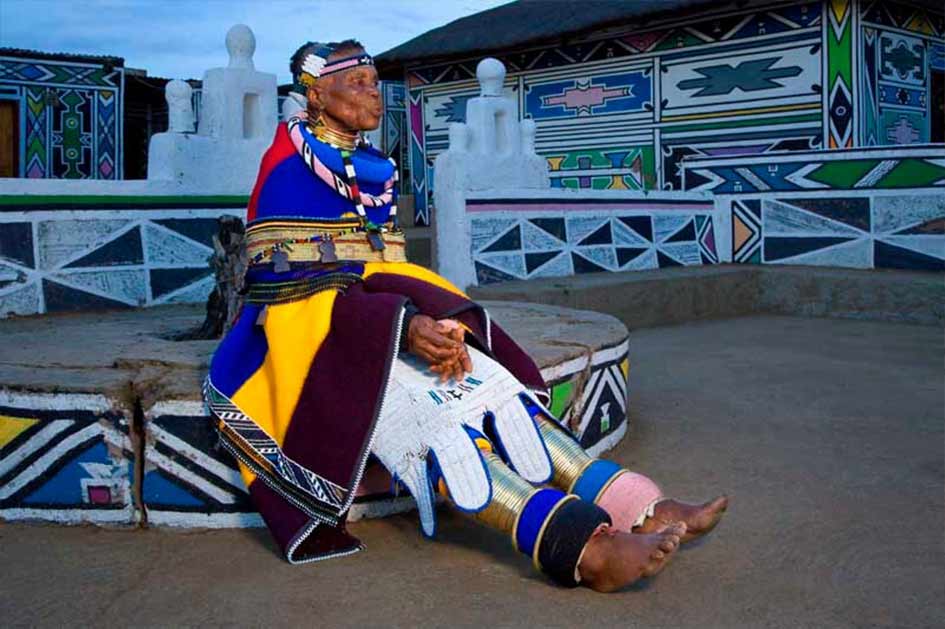
Esther Mahlangu at her residence. Photographer and copyright holder: Franz Jesche
ESTHER MAHLANGU
Esther Mahlangu is an exceptional artist who has seamlessly blended the traditional art of the Ndebele people with contemporary art, creating a unique and recognizable visual language.
Born in 1935 in the Mpumalanga region of South Africa, Esther Mahlangu learned traditional wall paintings and beadwork of the Ndebele from a young age, honing her skills as she grew older.
Mahlangu began working at Botshabelo Historical Village from 1980 to 1991. Her works were discovered by academics in 1986, leading to an invitation to participate in the “Magiciens de la Terre” exhibition in 1989. She painted a house in front of a large audience.
In 1991, Mahlangu became the first woman to participate in the BMW Art Car Project, painting geometric designs on a BMW 525i. This experience contributed to her international recognition.
Mahlangu’s art has been exhibited worldwide, from South Africa to Europe, the United States, Mexico, Australia, and other countries.
She established an art school in Mabhoko (Weltevreden), offering education to young Ndebele designers, thereby preserving the traditional heritage.
Esther Mahlangu has emerged as a significant figure in global art, successfully merging traditional cultural heritage with contemporary creativity.
Learn more about Esther Mahlangu [here]
You may also like
“Bandana: The Coolest Scarf and Its Story”
The bandana has re-emerged as a trend with a dynamic comeback in the fashion world. I wondered abo
Unfair wages for workers in the fashion industry in Bangladesh: Who is responsible?
Fair Trade: How Fashion Transforms into a Movement for Change
Let's start by exploring fair trade, also referred to as "ethical trade." This movement involves the

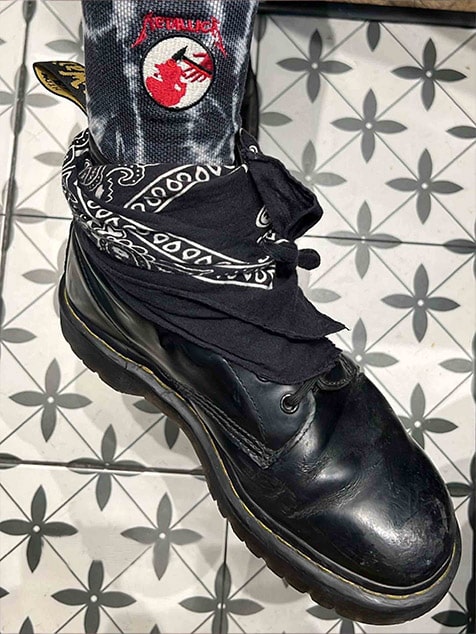


Post a comment